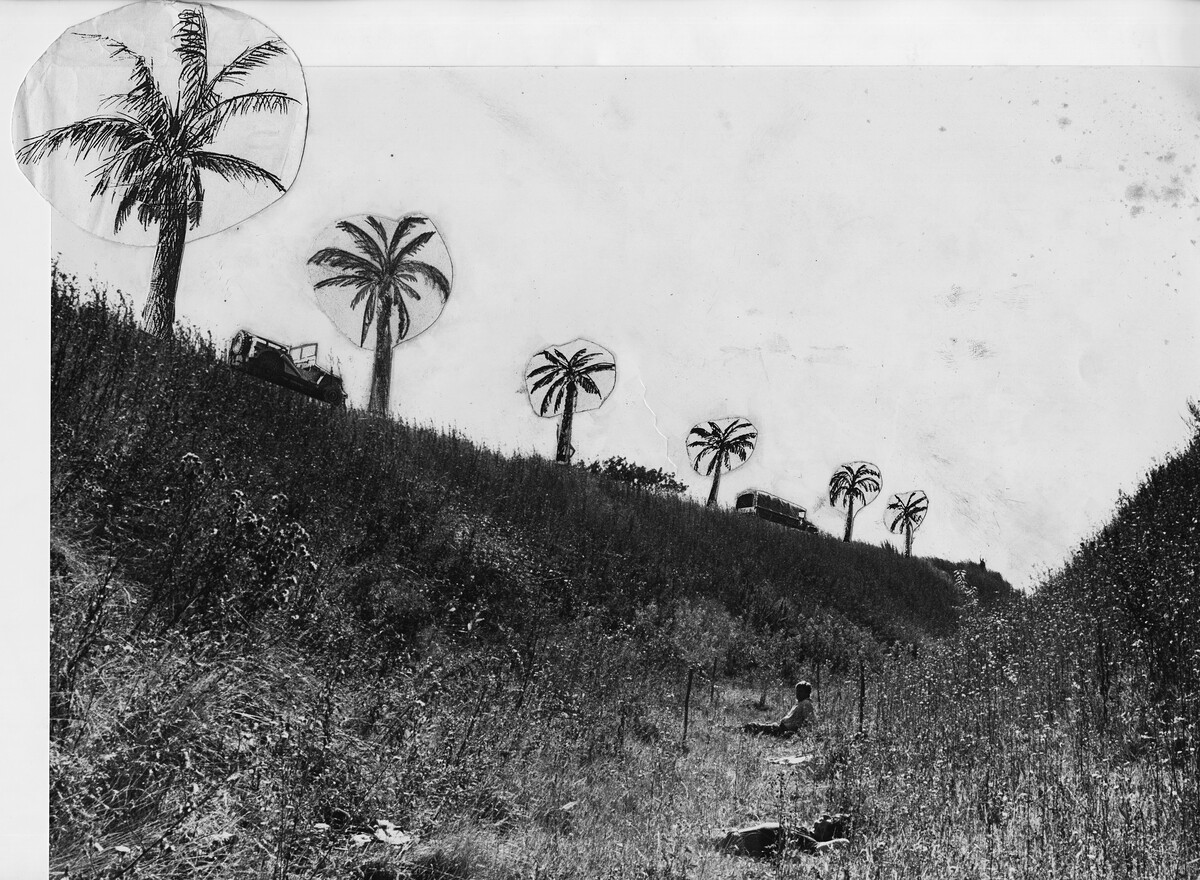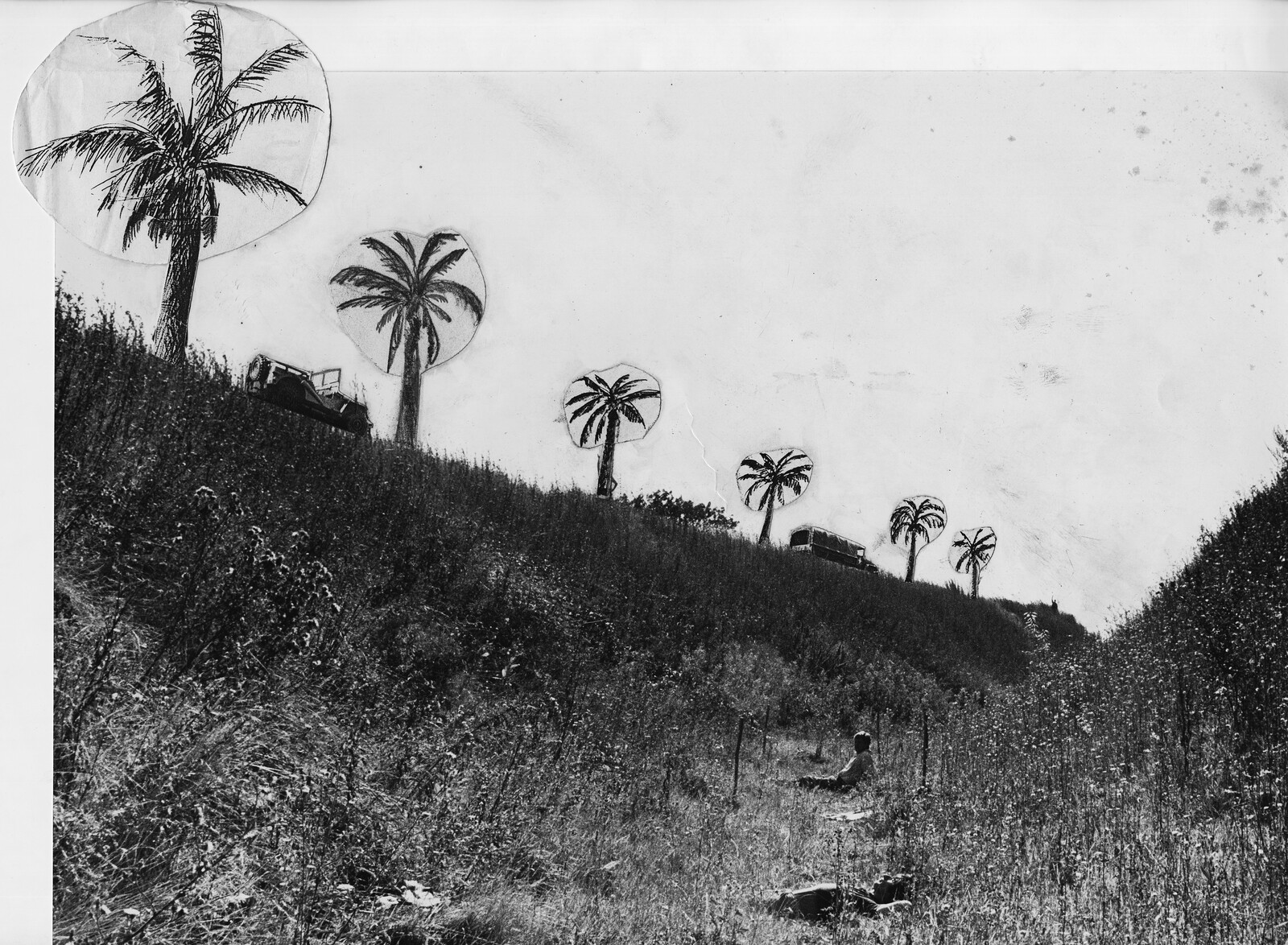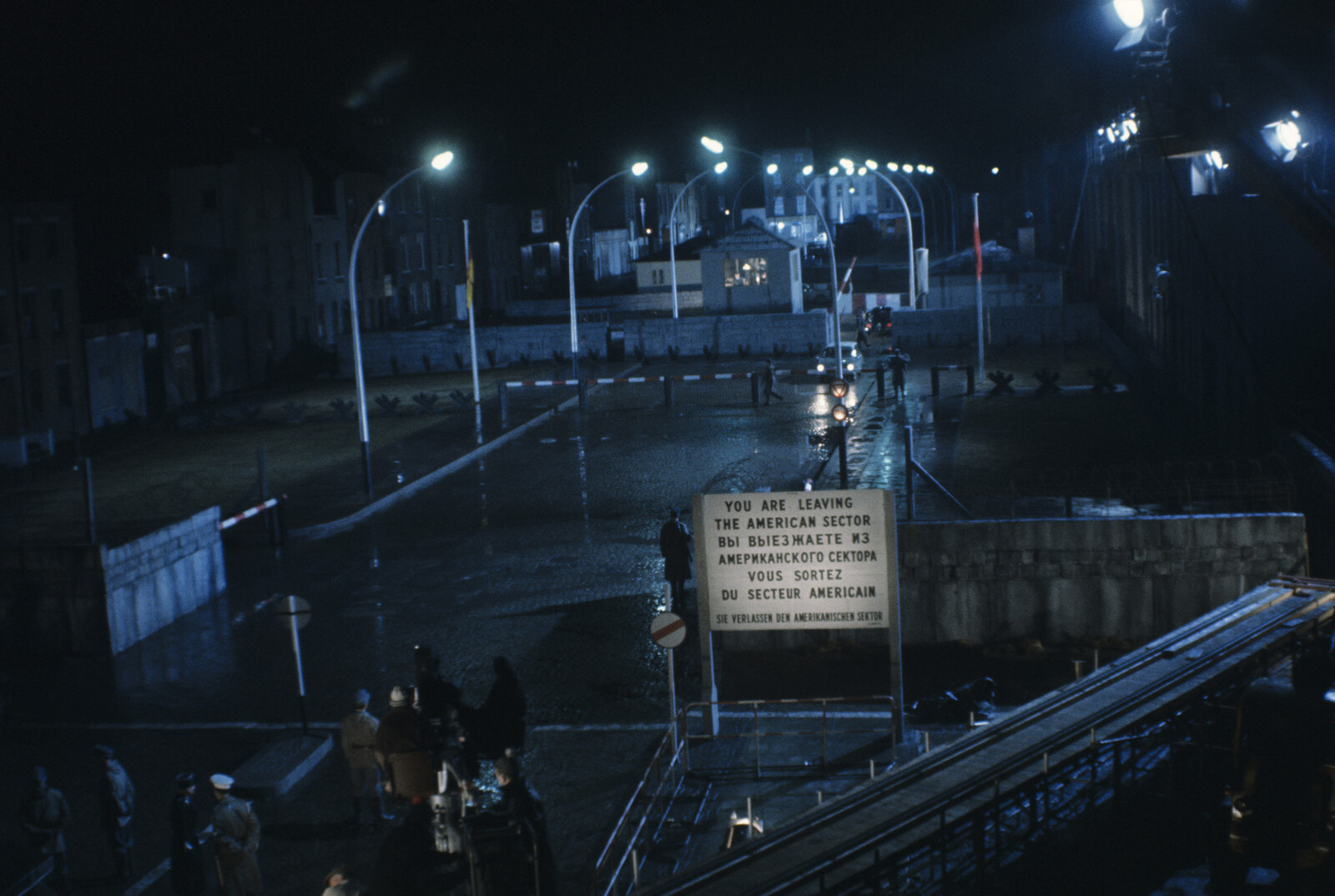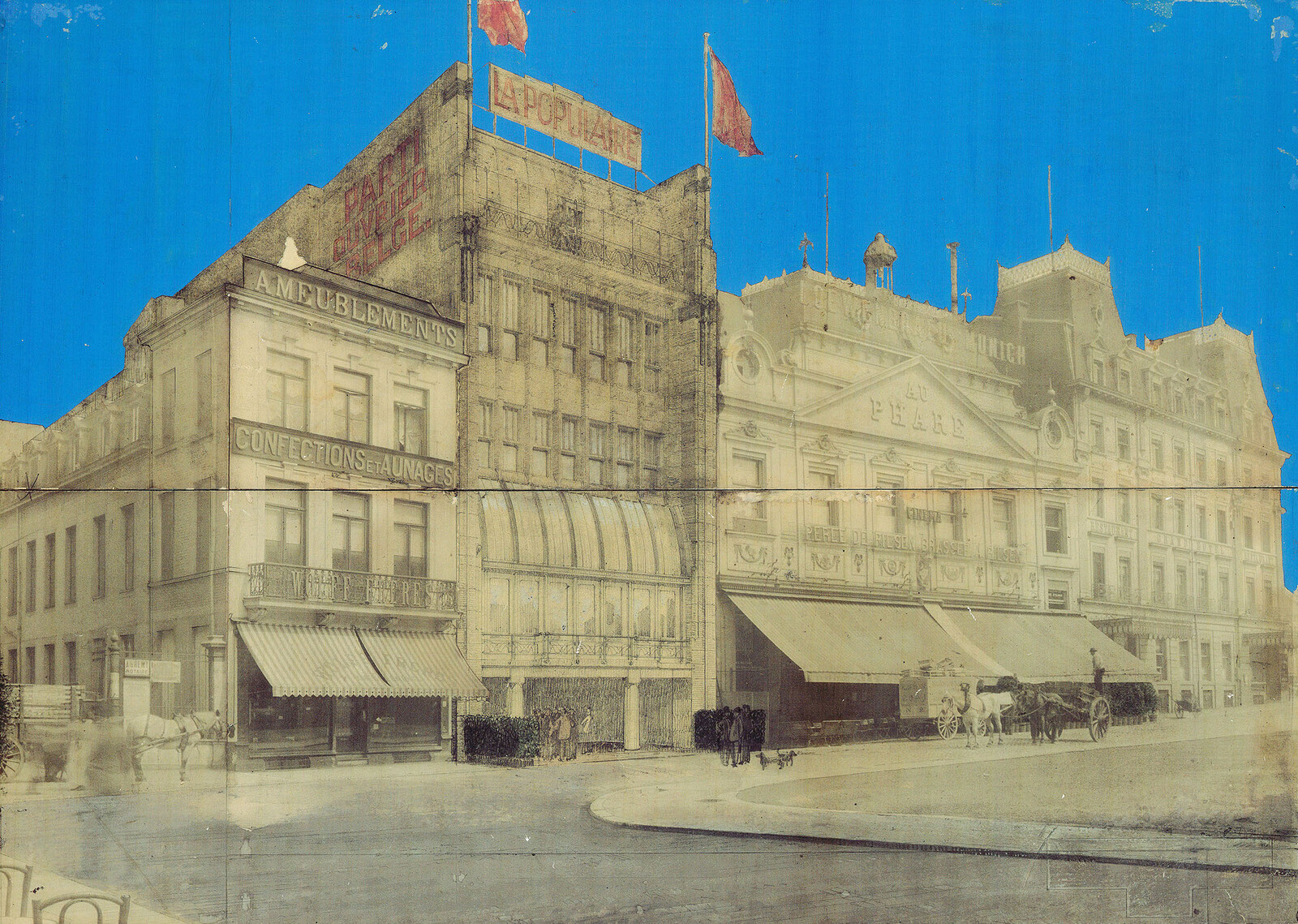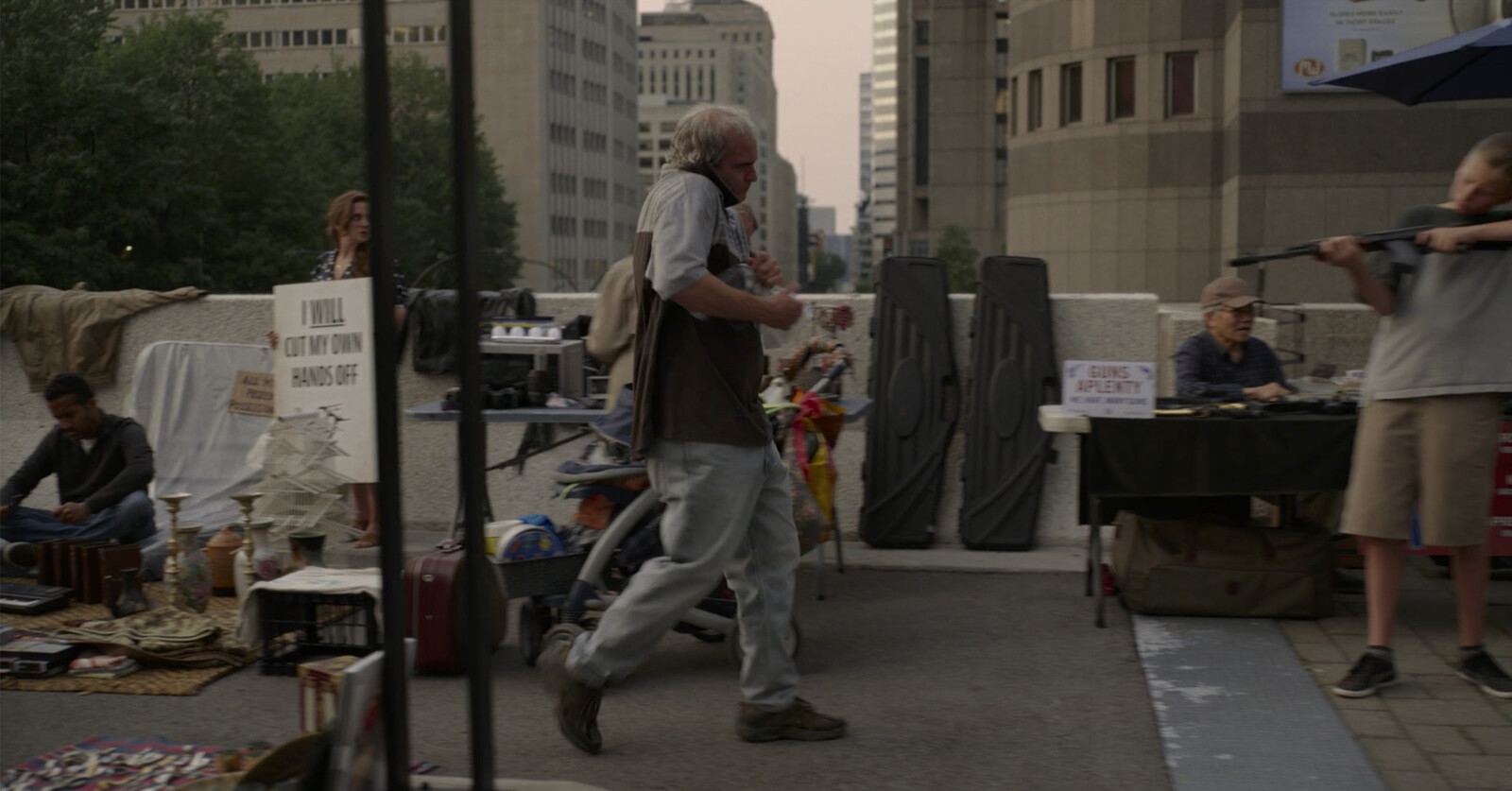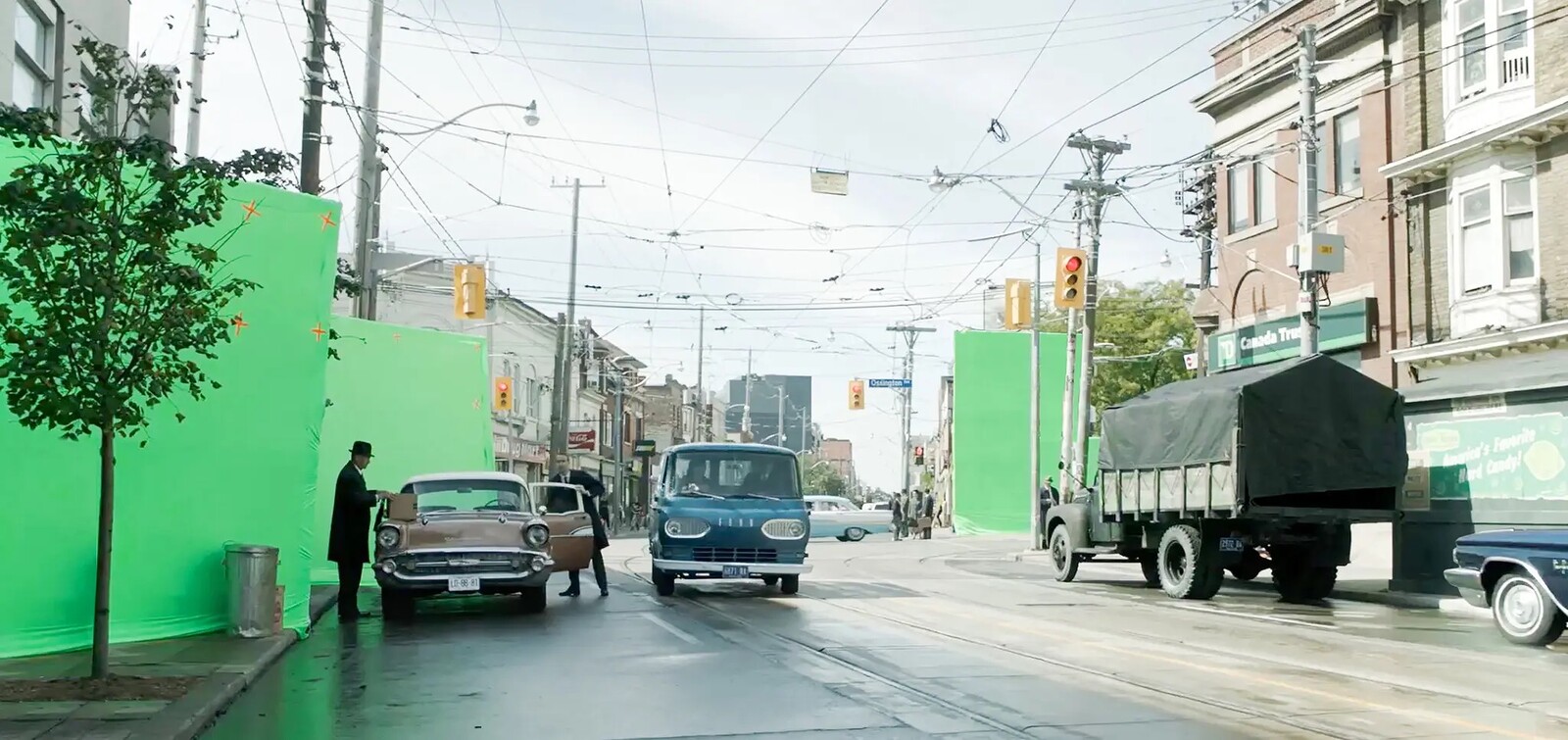Scene: On the “Radioactive Man” studio backlot, Nelson, Ralph, and Martin watch a scenic artist paint black patches on a white horse.
Martin: Uh, Sir, why don’t you just use real cows?
Scenic Painter: Cows don’t look like cows on film. You gotta use horses.
Ralph: What do you do if you want something that looks like a horse?
Scenic Painter: Ehh, usually we just tape a bunch of cats together.
—The Simpsons, “Radioactive Man”
“Would you tell me,” said Alice, a little timidly, “why you are painting those roses?”
Five and Seven said nothing, but looked at Two. Two began in a low voice, “Why the fact is, you see, Miss, this here ought to have been a red rose-tree, and we put a white one in by mistake.”
—Lewis Carroll, Alice’s Adventures in Wonderland
Hollywood is named after a vegetal imposter. The native Toyon (Heteromeles arbutifolia)—a plant with green leathery leaves, spiky edges, and bright red winter berries that blankets the foothills wherein the iconic sign sits—was wrongly dubbed “California Holly” by settlers who recognized similarities with its European namesake (Ilex aquifolium). Legend has it that this mislabeled evergreen inspired the name of the town. The holly of Hollywood(land) is not really holly.
This founding (albeit contested) mythology foreshadowed an indifference within Hollywood’s defining industry towards the classificatory schemas underpinning Western thinking about plants. A tree is a tree on film.1 Precisely what kind or species is generally immaterial. Unless diegetically essential, more nuance is difficult to justify, given the financial imperatives of production. After all, money doesn’t grow on trees.
Hollywood’s botanical apathy has often borne radical fruit, enabling motion pictures to represent vegetal life in ways which trouble orthodox systems of thought “bent on setting knowledge and existence within exact epistemic and ontological limits.”2 However, following a period of experimentation with vegetal movement in early twentieth century avant-garde film (influenced by the work of Jean Comandon, Mary Field, and Percy Smith), plants in narrative cinema have typically been relegated to the background.3 A concomitant “plant awareness disparity” reigns in contemporary discourse. While plants on film have become a fecund engine of speculation, they have garnered little attention.4 Cinematic vegetation has flourished, but quietly: fugitive filmic foliage, concealed and withdrawn, questioning categorization at the borders of the frame.
Given their peripheral presence on film, plants have often been used to implicitly generate a sense of place, particularly in productions where one location is required to masquerade as another (as a result of budgetary, scheduling, climactic, etc. constraints). Stanley Kubrick’s Full Metal Jacket (1987), for instance, is set in Vietnam, but was filmed at an abandoned gas factory in Beckton, London.5 Kubrick made the English factory site look like Hué City by importing 120 palm trees from Spain and 100,000 exotic plants (many of which were made of plastic) from Hong Kong. The trees were placed in large skips filled with soil that were then sunken into the ground. A specialist agency was hired to keep them alive for the nine-month shoot, after which they were simply abandoned. This unedifying take-make-waste approach to scenography renders any attempt to read these trees as environmentally progressive or relevant seem utterly perverse. Nevertheless, preparatory materials for the film reveal that initial—more pragmatic or “theatrical”—attitudes towards these trees influenced how they were staged, and this staging is deeply ecological.
A pre-visualization collage, made by cutting out drawings of the tops of palm trees and pasting/grafting them onto photos of other trees, appears to advocate for trees which are ontologically multiple. Plant species (drawn on paper) confound indexical representations of other plants (shot on celluloid). By confecting arborescent forms from myriad species, taxa, or ontological registers, Kubrick’s collage conceptualizes plants as “mediators between the organic and inorganic realms.”6 Trees become something different; a provisional confederation of heterogenous materials (timber, ropes, metal, soil) that erode any notion of “nature” possessing a preformed or static hierarchy. This is the type of plant that film sets can produce: a plant which is radically plastic (in the generative, life-giving sense), which moulds manifold discrete materials into a new, unforeseen thing.
Consistently, this kind of onscreen vegetation turns the margins of a movie into a site of material and biological experimentation. Plants on film become plants—hidden (double?) agents, lurking in the shadows, covertly determining what matter matters all while, given their ontological plasticity, resisting incorporation into human categories. This latent polyvalence resonates with a vegetal mode of being. Indeed, all life in plants is hidden (“vita in plants eat occulta”) yet they ceaselessly strive to become other in growth and reproduction, embodying “the most plastic form of existence.”7 In their theatrical, marginal reincarnation on film, plants possess a radical potential: to make manifest the plastic life of plants in ways that transfigure, defamiliarize, and ultimately reanimate “human experience along vegetal lines.”8
I. Generic Name: Arbor
Since the 1920s, pro-filmic vegetation has been overseen by greenspeople. A greensperson provides and cares for the assorted trees, shrubs, soils, and grasses (whether live or imitation) on film sets.9 Although not celebrated today, in the early part of last century, these movie gardeners were considered artists, whose “keen appreciation of form, mass, and color” had inspired a novel discipline.10 However, contemporary concerns emerged in response to the distortions of their craft. One article in Landscape Architecture longed for a time “when nationally acclaimed landscape architects will be retained by the great motion picture studios to ensure good taste and truthfulness in landscape representations in their pictures, in the same way that the great producers now retain experts in other fields.”11 While a greensperson often “[looks] for realism and on most films use real plants,” judging their output on the basis of verisimilitude alone overlooks the ability of filmic vegetation (and the agency of greenspeople) to subvert and repudiate static, ordered characterizations of nature.12 As Siegfried Kracauer observed in 1926, the transformative capacity of film sets resided in the fact that “nature, in body and soul, has been put out to pasture. Its landscapes are surpassed by those that are freely conceived.”13
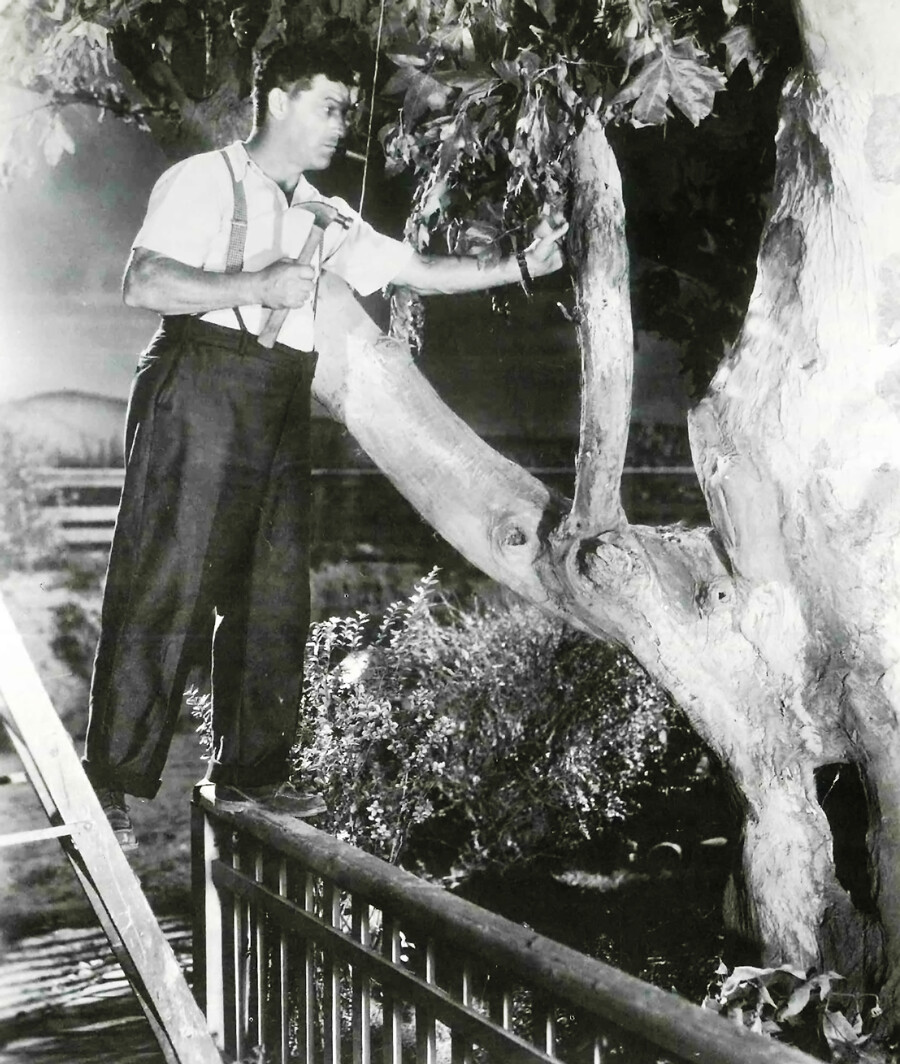

Greensperson from the Goldwyn art department hammering leaves on a tree for Wuthering Heights (1939), from the book Caligari’s Cabinet and Other Grand Illusions by Leon Barsacq (1976).
Freely conceived movie landscapes become ontologically and ethically sensitive towards plants when they engage with the theatricality of film sets; a performative mode which forges a more mutable relationship between persons and other materialities. In an article titled “Man and Object in the Theater,” Prague school theorist Jiří Veltruský recognized that on stage it is “impossible to draw a line between subject and object, since each component is potentially either.”14 For Veltruský, in the theater, a lifeless object may be perceived as the performing subject, and a live human being may be perceived as an element completely without will. (Quoting Jindřich Honzl, Veltruský observes that “tables may become beings whom we hate more passionately than our enemies.”)15 On stage, we consequently cannot speak of subject and object as two mutually delimited spheres. Instead, we must characterize their relation as “a dialectical antinomy.”16 There is not an equalization of things on stage (with the removal of special privileges and nothing favored or opposed), but rather a protean hierarchy (acknowledged when, in everyday language, we talk of particular things moving to “center stage” or “taking the spotlight”). It is this theatrical dance, and not some essential quality of the cinematographic medium, that coerces things to be different on film, and ensures that, as noted by Stanley Cavell, “there is a particular relation … that holds between things and their filmed projections … a relation to be thought of as something’s becoming something (say as a caterpillar becomes a butterfly).”17
Appreciating the ability of things (subjects, objects, and everything in between) to perform as other things—for a taped together bunch of cats to perform as a horse—is a big step towards a more ecological sensibility. Misuse is everything in a world of environmental catastrophe.18
It interrupts habit, urgently destabilizing social categories that “allow for easy partitions between valuable materials and rubbish,” while challenging the cultural dominance of late consumer capitalism (by “temporarily suspending the various networks of power that dictate the proper use of a given artefact”).19 Although the incredible dexterity of capitalism means that refashioned things are often co-opted to serve market ends, misuse is always there to deform and dislocate everything again.
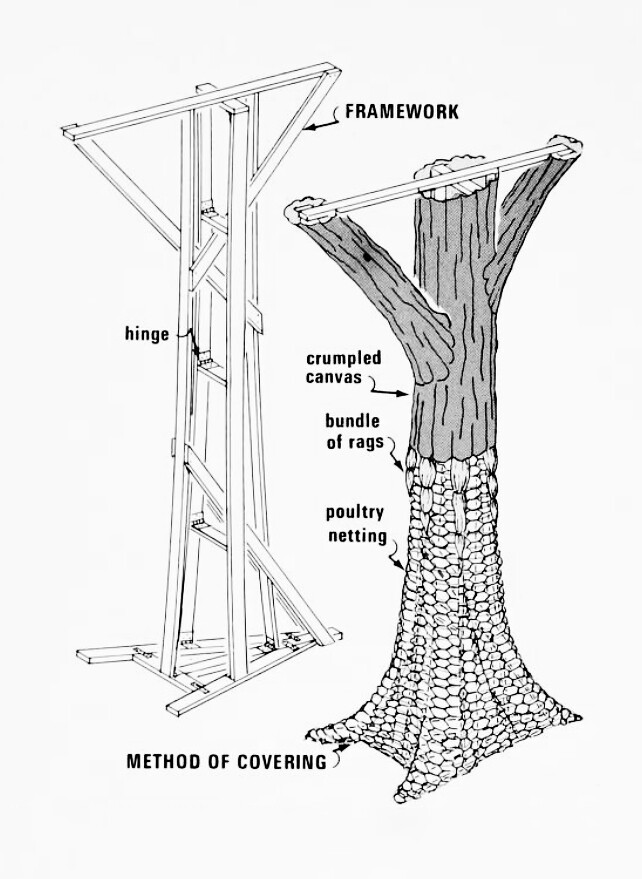

A studio tree from the book Scene Design - A Guide to the Stage by Henning Nelms (1970).
Prop trees participate in this ecology; as do real trees that happen to have grown on studio backlots, of which there have been many.20 Indeed, the majority of studio trees designed by greenspeople are material entanglements without equal. Nick Kaltenstadler of 20th Century Fox built more than one million trees for use in the movies, using thin, straight eucalyptus trunks as a foundation, primarily because they’re strong and easy to get. Over these poles are nailed kegs, and then a plaster of Paris bark made from an impression of any tree bark specified. Then painters cover it with the colors that will look most realistic in technicolor… [The leaves, which were often real, were] sprayed with a mixture of glue to keep them from shedding, varnish to give them highlights, and artificial color for a prettier panoramic picture.21
The tree becomes a sprawling unity, a container where, in Kracauer’s words, the fragmentary “things that rendezvous [within it] do not belong to reality. They are copies and distortions that have been ripped out of time and jumbled together.”22 Species collide, materials are overlaid, something new emerges. This does not make financial sense, as “the cost of a studio tree is twice that of a real one, but they can be altered and moved at whim.”23 By deploying strategies of theatrical misuse, by constantly reformatting and reusing stuff, the studio tree acknowledges plants as “synthetic assemblage[s] where the unity of the whole is only provisional,” thereby disrupting the insidious epistemological structures which underlie the science of classification.24
II. Specific Epithet: ficta
The problem with pursuing these “awkward, curious composites [that] materialize [a] wish to transfigure things as they are,” is that they risk exacerbating rather than mitigating the very environmental challenges they so artfully address.25 Noah Baumbach’s Margot at the Wedding (2007), for example, features a tree, which is scaled by the eponymous Margot (Nicole Kidman) who has returned home for her sister’s wedding at a Hamptons waterfront estate. This piece of filmic vegetation (an oak tree) was discovered by a tree surgeon on Long Island. It was “perfect for the production, except it was on private property, two miles away from the shooting location.”26 Instead of finding an alternative, or fabricating a studio version, a contractor dug the fully grown tree up, brought it down the Shinnecock Canal by barge, and bolted it into a concrete pad dug into the ground. No other changes to the tree were made. Hollywood’s indifference towards plants can patently foster harmful practices. This sort of environmental vandalism—the extraction of mature plants from their original locations—destroys years of hidden growth by extending technologies used since at least the 1600s to satisfy the demand for instant landscapes amongst a wealthy elite.27 Such damage cannot be justified if a film fails to irregularly reobjectify the tree, but what about when a film does? Do theatrical vegetal imposters—themselves the product of a botanical indifference—potentially reframe unethical acts of deracination as (in other ways) ecologically conscious?
Take, for instance, Michael Cimino’s Heaven’s Gate (1980), which features a tree at least 80-feet-high with a 60-foot crown and a fully mature appearance. A tree was “selected by the film company adjacent to a minor road some eight miles north of [a town an hour away]—a beech.”28 Given traffic regulations, however, the tree had to be dismantled; all major branches were removed from the trunk before transportation and stuck back on again on the film set. Because beech is brittle, the tree had to be carefully taken apart, numbered, and then reassembled using a variety of discreet fasteners. Then, “with reconstruction complete, the props department of the film company added branches and leaves of a Holm oak to give an adequate appearance of a tree in spring flush.”29 Unnecessary transplantation is regrettable. However, a tree of one species, branches and leaves of another, able to be taken apart and put back together at will, is a tree that productively promotes the ontological tensions and classificatory contradictions which emerge from a theatrical prioritization of plant life.


Film still from Michael Cimino’s Heaven’s Gate (1980).
Today, these techniques of (re)composition are increasingly displaced by computer generated vegetation. As Harun Farocki rightly observed regarding organic life on screen, “the era of reproduction seems to be over.” Digital images construct the world anew, defeating material manifestations of the world: “the pro-filmic is no longer the origin and ground of [images], but has become merely its discardable raw material.”30 Yet we lose something in this transition. The L-Systems and “imperfect factories” of present-day plant modelling are judged on their ability to iconically (or “realistically”) represent the morphology of various species. Visual verisimilitude dominates in contemporary cinema; trees are no longer sites of material and biological experimentation. Vegetation assumes a static identity; all plants become ontologically one.


L-system weeds: “realistic” models of natural patterns.
Although we will never know what it is like to be a plant, as Michael Marder rightly states, “the distance between us and other living creatures loses its static character as soon as the nominal categorial divisions between various “classes” of beings are shaken and muddled, without compromising these beings’ differences and commonalities. The gap separating humans from plants may dwindle—though not altogether disappear—thanks to the discovery of traces of the latter in the former, and vice versa.”31 This is what theatrical, cinematographic plants do; they collapse ontological categories by performing as material assemblages that exhibit what Gilles Deleuze described as the persistent “hint of the animate in plants, and of the vegetable in animals.”32 A tree is a tree on film. Precisely what kind or species is generally immaterial. Yet this botanical apathy has often nurtured onscreen plants in ways that are consonant with vegetal ontology: heterogenous, restless, plastic.
When asked by a director for an authentic-looking location in which to film, early twentieth century American film producer Abe Stern (co-founder of Universal Studios) responded: “A rock is a rock, and a tree is a tree. Shoot it in Griffith Park!” (the park was a 10 minute drive from the studio). See King Vidor, A Tree is a Tree (Hollywood, CA: S. French, 1989). Ronald Reagan, as governor of California (after a career in Hollywood), is also said to have remarked: “A tree’s a tree. How many more {redwoods} do you need to look at? If you’ve seen one, you’ve seen them all.’ See Martin H. Kriefer, “What’s Wrong with Plastic Trees?” Science 179, no. 4072, 1973.
Michael Marder, “For a Phytocentrism to Come” Environmental Philosophy 11, no. 2 (Fall 2014), 244. The word “radical” comes from Latin radicalis “of or having roots,” from Latin radix (genitive radicis) “root.” To be radical is ultimately to be vegetal.
Recent publications in response to the “vegetal turn” are rapidly expanding thinking on the relations between cinema and plant life. See Sarah Cooper, “Introduction: Thinking Cinema—With Plants,” Philosophies 8, 20 (2023); Teresa Castro, “The Mediated Plant,” e-flux Journal 102, (September 2019).
Plant awareness disparity (PAD) describes the cognitive bias or tendency to ignore plant life in one’s environment—a widespread and problematic phenomena that entrenches anthropocentric or zoocentric worldviews in research and society. I avoid the more ubiquitous term “plant blindness” given the ableism associated with it as a disability metaphor. See Kathryn M. Parsley, “Plant awareness disparity: A case for renaming plant blindness,” Plants, People, Planet 2, Issue 6 (2020): 598-601.
After decamping to England in 1969, Kubrick rarely flew anywhere (ostensibly as a result of a fear of flying), so the majority of his films had to be shot in the UK. It meant that for Kubrick the problem of needing certain UK locations to stand in for other places regularly reappeared. During pre-production for Eyes Wide Shut (1999), significant work was undertaken to find streets in London that would serve as convincing imposters of New York City (Commercial Road in East London, for example, was photographically surveyed in extensive detail).
Marder, 436.
Thomas Aquinas, Summa Theologica, translated by Fathers of the English Dominican Province (New York: Benziger Brothers, 1947); Marder, 12.
Antónia Szabari and Natania Meeker, Radical Botany: Plants and Speculative Fiction (New York: Fordham University Press, 2019), 26. Plants occupy a place on screen which is not “perfectly and precisely clear;” their meanings are hidden, obscured, not expressed within the films themselves. The pro-filmic event (containing plants) engendered by the camera can often only be understood through the analysis of extra-textual information (plans, written accounts etc.). To understand plants on film, we do, pace British film critic Victor Perkins, have to “attempt to clarify what the picture has obscured.” See Victor F. Perkins, “Must we say what they mean,” Movie 34 (Oct. 1990).
See Robert Ito, “It’s Not Easy Being Greenspeople,” New York Times, June 29, 2021.
“It is hardly too much to say that the Green {People} of {Hollywood} have produced, or are {now} rapidly creating, a new and most interesting American art form.” C. H. Larmore, “Gambol on the Green,” New York Times, December 29, 1940.
“Landscapes From The Screen,” Landscape Architecture Magazine 27, no. 3 (April, 1937): 146.
Barbara Baker, Let the Credits Roll: Interviews with Film Crew (McFarland & Company, 2004): 192.
Siegfried Kracauer, “Calico-World: The UFA City in Neubabelsberg,” The Mass Ornament: Weimar Essays, edited and translated by Thomas Y. Levin (Cambridge, MA: Harvard University Press, 1995), 285.
Jin Veltruský, “Man and Object in the Theater,” A Prague School Reader in Esthetics, Literary Structure, and Style translated by Paul L. Garvin (Washington, D.C.: Georgetown University Press, 1964), 90.
Ibid., 88.
Ibid., 91. See also Andrew Sofer, The Stage Life of Props (Ann Arbor: University of Michigan Press, 2003).
Stanley Cavell, Themes Out of School: Effects and Causes (San Francisco, CA: North Point Press, 1984), 173-174.
Film sets have historically been fertile spaces for material reuse. They are environments that anticipate the future use/life of objects, where “nothing is meant to last; the most grandiose creation is built with an eye to its demolition.” Kracauer, 283. See Aude-Line Duliere, “The Turn of the Screw and Other Short Stories on Dismantling and Reuse,” Wheelwright Prize Lecture, Harvard Graduate School of Design, accessed April 14, 2023, ➝. Although it is precisely this material ingenuity that others have disparaged: “High on the list of irritating services are the purveyors of artificial foliage to the theatre. They subscribe to the limited view that nature is stamped out of old window shades.” Howard Bay, Stage Design (New York: Drama Book Specialists, 1974), 124.
Raymond Malewitz, The Practice of Misuse: Rugged Consumerism in Contemporary American Culture (Stanford, CA: Stanford University Press, 2014), 4-7.
A tree from the Warner Bros. Ranch which dozens of sets were built around (the last for the 1938 film Jezebel) was lost in a storm in 1938. See “Oft-Filmed Tree is Gone; Hollywood Oak, in Many Love Scenes, Is Blown Down,” New York Times, March 27, 1938. Also the “Witness Tree” at Paramount Ranch, which burnt down in the 2018 Woolsey Fire. See “Paramount Ranch’s majestic Witness Tree to be cut down, a victim of Woolsey fire,” Los Angeles Times, February 8, 2020.
H. Hopper, “Hollywood Sets Would Fool Mother Nature,” Los Angeles Times, November 26, 1939.
Kracauer, 281. What makes prop trees notable in this regard is that they are traditionally made from timber in multiple different guises (which is what makes them “double” agents): sawn wood, paper, even plastic, for ‘what are fossil fuels and plastics but the petrified bodies of once-living photosynthetic creatures.’ See Natasha Myers, “Photosynthesis,” Society for Cultural Anthropology, January 21, 2016. See ➝.
Hopper.
Michael Marder, Plant-Thinking: A Philosophy of Vegetal Life (New York: Columbia University Press, 2013), 43.
Bill Brown, “How to Do Things with Things (A Toy Story),” Critical Inquiry 24, no. 4 (1998): 964.
Ito.
A phenomenon familiar to anybody who has seen Salomé Jashi’s devastating documentary Taming the Garden (2021). As Toby Kiers reminds us, “for hundreds of years, these ancient trees have been cultivating their unique underground ecosystems, including vast fungal networks supporting the tree since it was a tiny sapling… When a tree is uprooted, that life support system gets ripped from the soil, leaving behind a barren wasteland.” Ivan Nechepurenko, “A Love of Trees or a Display of Power? The Odd Park of an Oligarch,” New York Times, January 17, 2022.
I. J. Keen, “An Unusual Contract or How to Approach Heaven’s Gate,” Arboricultural Journal 4, no. 2 (1980): 141.
Ibid., 144.
Thomas Elsaesser, “Simulation and the Labour of Invisibility: Harun Farocki’s Life Manuals,” Animation 12, no. 3 (2017): 218.
Marder, 9.
Gilles Deleuze, Bergsonism (New York: Zone Books, 1991), 95.
Impostor Cities is a collaboration between e-flux Architecture and The Museum of Contemporary Art Toronto within the context of its eponymous exhibition, which was initially commissioned by the Canada Council for the Arts for the 17th Venice Architecture Biennale.
